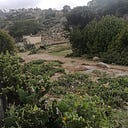Däqiqä Ewosṭatewos (Ewosṭateans) and the Council of Florence (1441)
The Ewosṭateans were a Christian cenobitic monastic movement founded by Abune Ewosṭatewos in the 14th-century who insisted on Sabbath observance basing his position in the 10 commandments and the Canons of the Apostles. Despite Ewosṭatewos dying in exile, his followers founded several monasteries such as Däbrä Bīzen, Yitain and Maryam, in the northern kingdom of Ma’īkele Bahr (modern-day Eritrea).
After a century-long internal schism, the mainline Ethiopian Orthodox Church officially adopted the Sabbatarian observance of the Ewosṭateans at the Council of Däbrä Miṭmaq in 1450, which remains one of the distinctive markers of Ethiopian Orthodoxy in contrast to the other Apostolic churches. What does this have to do with the Council of Florence far away from the rugged highlands of Ethiopia and Eritrea across the Mediterranean and the vast Sahara Desert? Only a decade before the Council of Däbra Miṭmaq, Ewosṭatean monks were present at the ecumenical Council of Florence. Did they represent the Ethiopian Orthodox Church? What was their influence?
Tewodros, Didimos, Giyorgis, and P̣etros were the names of the Ewosṭateans monks and information about their diplomacy include a Ge’ez letter, translated into Italian, an oration given before Pope Eugenius IV by P̣etros (who was lead Ewosṭātean delegate) and an interview by a papal committee examined via the accounts of it offered by two papal secretaries who were present. Biondo Flavio and Poggio Bracciolini were the names of the two papal secretaries whose accounts are recorded in “Decades” and “Historia de varietate fortunae”. Given the general ignorance of the Ge’ez language in Europe, the Ewosṭatean delegates are believed to have spoken in Arabic and their words were translated by two interpreters, one Arab and one Italian.
The reliability of Biondo Flavio and Poggio Bracciolini can be seen through various lenses, but a rather humorous example is the delegates’ protest of how the appellation “Prester John” to the king of Ethiopia was utterly “absurd and unworthy” despite Biondo continued insistence that “Prester John” was an acceptable title for the king of Ethiopia, claiming that it was used in Egypt and Syria. However, Biondo affirming the Ewosṭātean affiliation of the delegates is what stands out most in his writings:
“… although they solemnly observe Sundays, they also keep the Sabbath, abstaining from all manual labour on this seventh day.”
If written a decade after, it wouldn’t have been controversial following the decree at the Council of Däbrä-Miṭmaq. However, Sabbath observance in 1441 distinguished these delegates as unorthodox Ewosṭātean monks despite King Dāwīt II ending their persecution by lifting the ban of excommunication in 1404. It has been argued that delegates’ king, Zär’ā Yāʿiqōb, was sympathetic towards them thus portraying it as a feature of the entire Church, but the evidence for this is thin. A clue that contradicts this assessment can be found in their claim:
“… even the ruler is permitted only one wife though if she dies he is permitted a second, and a third — but no more.”
Were the Ewosṭātean monks lying, being ignorant or making a statement about the nature of their faith? Royal polygamy has a long tradition in Ethiopia, and Abune Ewosṭātewos himself was known to publicly criticize it. The statement made by the monks is better interpreted as an indirect critique of royal marriage practices which was a dangerous pursuit that led kings, such as ʿAmda Ṣyōn, to persecute the Ewosṭāteans in the first place.
The Ewosṭāteans not only survived the persecution, but thrived throughout the empire, and their continued pressure for the full integration of Sabbath observance now persisted beyond national and ecclesiastical borders. Now, this raises an important question: why an Ewosṭātean representation whose authorities regarded them as schismatics?
The delegates were monks from Jerusalem and their Abbot, Nicodemus, was himself an Ewosṭātean who saw the opportunity in Florence to voice his vision of an orthodox practice and counter the Coptic patriarch who had informed the papal envoy in 1440 of his right to represent Ethiopia. As previously mentioned, Zär’ā Yāʿiqōb had no particular sympathy towards Ewosṭāteans but Nicodemus’ letter to Pope Eugenius IV presenting himself as a conduit to the king immensely influenced the theological and political landscape which is reflected in Zär’ā Yāʿiqōb letter to the monks (1442):
“I entrust my prayers to your afflictions, which you suffer for the love of God. From my heart, I greet you saying: Greeting, sons of Ethiopia, whom the earthly Jerusalem has held captive in order to lead you to the heavenly Jerusalem. Greetings to your faith in the perfect Trinity, to your monastic life, similar to that of the angels… May your peace, your love, your prayer and your blessing be with me forever, Amen. Herewith I send to you this book of the Sinodos, so that you may take consolation from it on the days of the Sabbath and Sundays.”
International stature and access to influential foreign Christian leaders that the Ewosṭāteans achieved earned them his favour. They would bring back with them a letter from Pope Eugenius IV to Zär’ā Yāʿiqōb expressing his hope for a union, as with the Copts, and military alliance. It must be reminded that Zär’ā Yāʿiqōb was no more a king than he was a “theologian” — undoubtedly the most influential one in Ethiopian history. Not only would the decree at the Council of Däbrä-Miṭmaq heal a schism and augment royal influence in the northern kingdoms, providing a launching point for military campaigns against the Muslims in the Eritrean coast, but also increase the potential in creating a distinctive, national church independent of the authority of the Alexandrian See, directed by the king himself. The latter was definitely accomplished to an extent throughout the many years making Ethiopian Orthodoxy stand out among its Apostolic sister churches, and leading up to its solidification in 1959 with its own autocephaly.
Yonathan Alem
